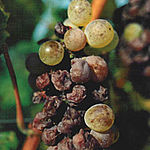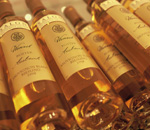-

Weingarten Herbst Header
-

Weinglas R Header
-

Weinrebe Sonnenuntergang Header
-

Weinfässer Header

It’s a miracle which unfolds each and every year in Rust, a natural consequence of the interaction between the area’s special climate, topography and soil quality. The Ruster Ausbruch: one of the most impressive sweet wines in the world whose European counterpart can only be found in a Hungarian Tokaj or French Sauterne. Ruster Ausbruch may be defined as botrytised wine that has for centuries been linked to town history.
The name stands for a special type of sweet wine made from grapes that are left to hang on the vine longer than usual. These grapes become host to a rare beneficial fungus called Botrytis Cinerea that develops only in regions where warm summers, mild autumns and fog from nearby waters interact to create optimal conditions. As a result, the grapes soften and shrivel into raisin-like berries that concentrate the grapes’ acidity, sugar, extract and aromas.
The picking of grapes affected by this noble rot can only be done by hand in several laborious runs. Since the grapes are not always equally affected, the suitable parts have to be individually removed (“broken out”). Balance along with highest concentration is the utmost aim. Ruster Ausbruch fascinates by its multi-layered aromatic compounds and a fanciful play of sweetness and acidity on the palate. The sparkling in the glass is mirrored in the flaming temperament of the wine.

Whoever believes that Ruster Ausbruch complements only desserts is totally wrong: naturally it’s delicious with the typical Austrian sweets but it can also very well be served as an aperitif or in combination with noble blue cheese or goose liver. It is even a very nice companion to espresso. Its long ageing potential always conveys a sense of longevity.
As the history of the town of Rust testifies, even the Habsburg Family appreciated the specific characteristic of this wine. As early as in the 15th century, the town of Rust - at that time already trading in wine - bought the town charter from Emperor Leopold I in 1681. They paid the sum of “60.000 gulden and 500 buckets of Ruster Ausbruch,” which would today be equal to 300,000 litres of the precious wine. Reason enough to continue tradition!